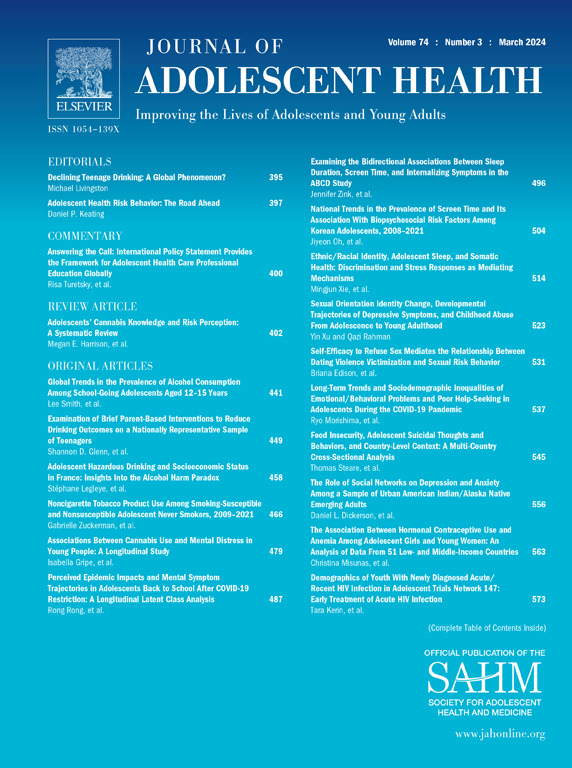谁玩谁不?对青少年运动和体育活动课参与差异的交叉研究》。
IF 5.5
2区 医学
Q1 PEDIATRICS
引用次数: 0
摘要
目的:在研究青少年参与有组织运动和体育活动(PA)的情况时,很少有报告包括 1-2 种以上的社会身份。我们采用定量交叉的方法来研究青少年参与体育和体育活动课的差异:方法:2022 年九年级和十一年级明尼苏达学生调查参与者(N = 62,940)自我报告了社会身份以及团队运动和体育活动课程。社会身份包括出生时的性别、性别模式、性身份、种族和民族身份、获得资源的机会(即经济状况)、体重状况以及心理健康/行为/情感问题。我们使用了详尽卡方自动交互检测法,以确定具有不同交叉社会身份的青少年的参与率:结果:半数样本参加了体育运动,四分之一参加了体育活动课。在不同社会身份的交叉点上,参与情况有很大差异。参与率最高的体育运动组别中的参与者主要是白人、异性恋者,并且拥有较多的资源,而参与率最低的组别中的参与者则拥有多重边缘化的社会身份:在获得资源最少的青少年中,只有 12.8%的人参加了体育运动,他们对自己的性别身份和性身份存在疑问,或者报告了未列出的性身份。关于体育活动课,流行率最高的群体中的青少年主要是异性恋者,获得资源的机会最多,并且是有色人种青少年;相比之下,流行率最低的群体中的大多数青少年获得资源的机会中等/较低,并且/或者体重指数较高,而且通常具有不同的性、性别或种族/民族身份:讨论:被多重边缘化的青少年在体育和课外活动课程中的代表性不足。各组织应解决参与过程中遇到的各种障碍。本文章由计算机程序翻译,如有差异,请以英文原文为准。
Who Plays and Who Doesn't? An Intersectional Examination of Disparities in Adolescent Sport and Physical Activity Lesson Participation
Purpose
Few reports include more than 1–2 social identities when examining organized sport and physical activity (PA) participation among adolescents. We used a quantitative intersectional approach to examine disparities in adolescent sport and PA lesson participation.
Methods
Ninth and 11th grade 2022 Minnesota Student Survey participants (N = 62,940) self-reported social identities and team sport and PA lessons. Social identities included sex assigned at birth, gender modality, sexual identity, racial and ethnic identity, access to resources (i.e., economic status), weight status, and mental health/behavioral/emotional problems. We used Exhaustive Chi-square Automatic Interaction Detection to identify prevalence of participation among adolescents with different intersecting social identities.
Results
Half of the sample played sports and one-quarter participated in PA lessons. Participation varied substantially at the intersections of social identities. Whereas participants in the highest prevalence sports participation groups were predominantly White, heterosexual, and had high resource access, participants in the lowest prevalence groups held multiple marginalized social identities: only 12.8% of adolescents with least access to resources who were questioning their gender identity and sexual identity, or who reported a sexual identity not listed, participated in sports. Regarding PA lessons, youth in the highest prevalence groups were predominantly heterosexual, had highest access to resources, and were youth of color; by comparison, most of the lowest prevalence groups comprised youth who had medium/low resource access and/or high body mass index, and often a diverse sexual, gender, or racial/ethnic identity.
Discussion
Multiply marginalized adolescents are under-represented in sports and PA lessons. Organizations should address interlocking barriers to participation.
求助全文
通过发布文献求助,成功后即可免费获取论文全文。
去求助
来源期刊

Journal of Adolescent Health
医学-公共卫生、环境卫生与职业卫生
CiteScore
10.40
自引率
3.90%
发文量
526
审稿时长
46 days
期刊介绍:
The Journal of Adolescent Health is a scientific publication dedicated to enhancing the health and well-being of adolescents and young adults. Our Journal covers a broad range of research topics, spanning from the basic biological and behavioral sciences to public health and policy. We welcome a variety of contributions, including original research papers, concise reports, literature reviews, clinical case reports, opinion pieces, and letters to the editor. We encourage professionals from diverse disciplines such as Anthropology, Education, Ethics, Global Health, Health Services Research, Law, Medicine, Mental and Behavioral Health, Nursing, Nutrition, Psychology, Public Health and Policy, Social Work, Sociology, and Youth Development to share their expertise and contribute to our mission of promoting adolescent health. Moreover, we value the voices of young individuals, family and community members, and healthcare professionals, and encourage them to submit poetry, personal narratives, images, and other creative works that provide unique insights into the experiences of adolescents and young adults. By combining scientific peer-reviewed research with creative expressions, our Journal aims to create a comprehensive understanding of the challenges and opportunities in adolescent and young adult health.
 求助内容:
求助内容: 应助结果提醒方式:
应助结果提醒方式:


